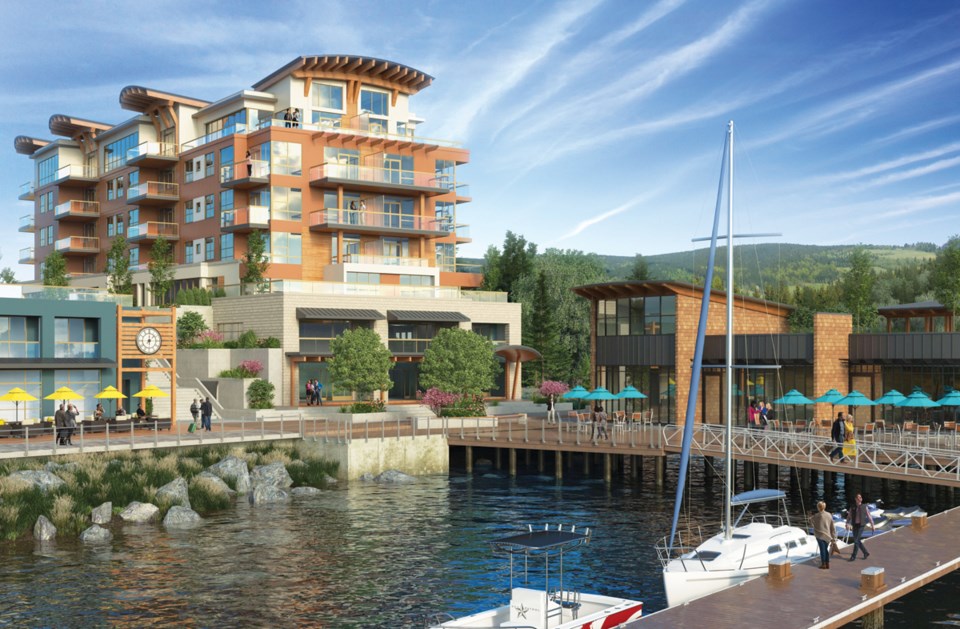An Environmental Appeal Board (EAB) hearing on whether the province should have endorsed a remediation plan for the site of the George Hotel and Residences in Gibsons has been adjourned until next year.
The request for adjournment came from the developer’s lawyers.
Klaus Fuerniss and The George Gibsons Development Ltd. are a third party in the appeal, which was launched by the Gibsons Alliance of Business and Community (GABC) against a decision by a Ministry of Environment official.
The central issue is whether the ministry should have granted a “statement of support” for the plan to remediate the construction site, which is suspected of having contaminated soil from previous industrial activity.
In a letter to the EAB, the company’s lawyers say, “The adjournment is sought in order to accommodate further investigations and testing at 377, 385, 397 and 407 Gower Point Road and 689 Winn Road and Winn Road right-of-way … and the adjacent impacted foreshore water lot leases.”
The request for an adjournment goes on to say, “The proposed additional testing and investigations relates to tributyltin (TBT) and to the protection of the Gibsons aquifer” and that the additional work is needed, in part, to ensure the so-called “site profile” and application for a certificate of compliance are in line with “amendments to the Contaminated Sites Regulation (CSR), which came into force on November 1, 2017. The amendments revised soil and sediment standards for many substances and introduced new parameters for substances not previously regulated.”
There will also be additional geotechnical work, which is being described as “necessary to provide sufficient information to finalize the design of the ground improvement for the proposed onshore buildings and the foundation system for the offshore proposed developments at the project site, with respect to the protection of the Gibsons aquifer.”
Both GABC and the ministry have agreed to the adjournment, and Suzanne Senger, who was until last week president of GABC, said the group considers the request for an adjournment confirmation that “GABC was right from day one.”
“We found that there were issues, the issues are real and The George is now acknowledging that their remedial plan does not comply with the contaminated sites regulations,” Senger said. “They still have to look at the issue of tributyltin in the sediments, which they have not adequately done, and there are serious risks to Gibsons aquifer because they haven’t addressed the geotechnical issues.”
She claims the result was the Town issuing permits for a plan that was flawed and based on incorrect information and that did not comply with provincial environmental regulations.
Senger also said she remains cautiously hopeful that the new studies will lead to a site remediation plan that GABC could support.
“The ideal is that we force the developer to finally come up with a remedial plan and a project plan that pose no risk to the environment and the aquifer and we can avoid the EAB hearing altogether.”
Senger said GABC has also succeeded, through the EAB appeal and an earlier, unsuccessful, court challenge, in getting the government to look at reviewing the rules that allow municipalities to opt out of the contaminated sites remediation process, turning it over to developers and the Ministry of Environment.
“The B.C. government now sees that what we’re saying is true and the process is broken and they need to resolve it,” she said. “They’re looking at removing the opt-out provision for the site profile. That would have forced the Town’s hand at the beginning of this process and made them be involved.”
Fuerniss told Coast Reporter via email that his company’s environmental plan for the site is “a living document” that calls for ongoing testing and remediation in cooperation with the Ministry of Environment and the Department of Fisheries and Oceans to meet the requirements of the Town-issued Environmentally Sensitive Areas Development Permit (ESA-DP).
He said it makes sense to delay the hearing so the EAB can have the most up-to-date information.
“Right now, we are in the window where remediation and testing will have least impact on the environment,” Fuerniss said. “We have just begun site preparation, revealing areas where we could not previously conduct tests. Throughout this process we will be regularly submitting reports and plans on the process. This is a condition of the ESA-DP which we must, and will, adhere to.”
Fuerniss also remains critical of GABC for “multiple legal challenges attempting to delay the project.”
“Each of the challenges has been dismissed after costing the Town and my company hundreds of thousands of dollars in legal fees,” Fuerniss said.
The additional studies will be done by Keystone Environmental and Horizon Engineering, consultants that have been working on the project since its early stages.
According to the documents submitted to the EAB, Keystone’s additional work could be done as early as December and the geotechnical work, to be done by Horizon, will take up to 24 weeks.
Fuerniss said the work being recommended by Keystone and Horizon was already factored into the timeline for construction. “It certainly won’t delay it. Absolutely not,” he said.
The new date for the EAB hearing, which will be held in Sechelt, is Oct. 21, 2019.



